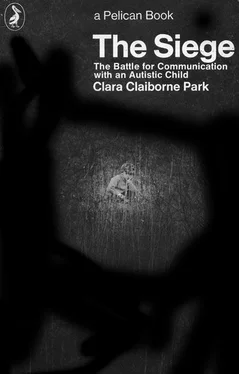The children have learned not to talk to Elly unless I am there to act as interpreter — an interpreter not even of speech, but of behaviour. It is simply too hard for them. Sometimes there is a brief contact, as in taking turns on a swing. But where, either because of inability or shyness, neither party will take the initiative, there can be no real interaction. I am trying to encourage Elly to answer when a child says ‘Hi, Elly’. So far, I am encouraged — but the child is bewildered — if she echoes ‘Hi, Elly’, back.
But here too there are mysteries. Elly can be contrary, and she knows how to tease. She will rarely greet someone she knows well, but on occasion she will rush up to some college boy she has never seen before and embrace him on the street. He, of course, is as embarrassed as I am, and Elly looks at us with mischief in her eyes. Or she makes — not often — a clumsy overture to another child, an overture that would have been reciprocated had she made it when she was two, to another two-year-old, but that normal children now find bizarre and frightening. It is hard to build sociality on these fitful and easily discouraged advances.
Elly is now in the class for the educable retarded at our local public school. After three years with normal children, the private school considered it impossible to move her into even their extremely small first grade. Ironically, it was because she had made so much progress that they could not keep her. She was no more strange than she had always been, but as she has improved her strangeness has acquired a much higher visibility. Now that she can ‘act out’, she is no longer the silent child who took directions and caused no trouble, but a spring-tight, hyperactive little girl who uses her voice and her whole body to express the emotions, positive and negative, that are at length available to her. Newly at large in the world of feeling, she must learn to control it, and that without converting control into repression.
It is not easy. Her first weeks in the public school required manifold adjustments and imposed severe tensions on teacher, pupils, and administration — tensions that were absorbed with a flexibility, imagination, and good will that quite literally pass belief. That I do not describe them here at length only illustrates that there is never space for all the important things. Elly’s new teacher knows that Elly’s very difficulties show that she is now ready to profit from what no home care and no one- to-one relationship, however devoted, can give her; the opportunity to be led, step by step, with imagination and understanding, into minimal interaction, not with a sympathetic adult, but with her peers.
Elly is learning a great deal in the new school. Slowly and reluctantly she moves through the primer. With eager enthusiasm she fills out the exercises in visual perception that the other children find so hard. Stage by stage she advances in arithmetic. But all this is secondary; the teacher does not need me to tell her so. For Elly, for whom each interaction must be learned separately and again and again, the important subject is Deportment. To speak in greeting, face up, voice audible, while standing neither so close as to embarrass nor so far that the greeting goes unnoticed — to share attention — to respond to an overture — to take part in a game — to listen with patience and ultimately with comprehension to a storybook or to a schoolmate’s simple account of the rabbit he keeps in his backyard — these are Elly’s lessons. She may be solving quadratic equations before she learns them all.
The ten retarded children in her class are good teachers. They are more tolerant of deviant behaviour than normal children would be, knowing their own behaviour leaves much to be desired and has not always met with acceptance. The wise and loving young woman who teaches them knows how to show them that they can help Elly and feel good about themselves at the same time. As one boy said in the first bad days, with satisfaction and surprise, ‘Elly can do arithmetic better than me but I behave better.’ And it is behaviour , in its fullest sense, that Elly has now to learn. The private school, even as they excluded her, expressed dismay that she had now to be put into a class for the retarded. ‘She’s really a bright little girl.’ I do not know what ‘really’ means in this context, but I know that these retarded children, far from holding her back, are light-years ahead of her in adequacy and function. Taking my semi-weekly cafeteria duty, I listen astonished as these supposedly backward children assert their full humanity. ‘Hey, what’re we having for lunch? You want to know what I did yesterday? What’s this stuff? I hate prunes, don’t you? You want mine? Will you play with me after? We need the ball, Johnny’s got it. Come on, don’t be mean, Johnny! He’s always like that. Do you want me to pop you one?’ I listen in wonder. This is retardation, these pronouns, these prepositions, these verbs, with their auxiliaries and their tenses, this mastery of verbal and social idiom? Yet some of these children, at thirteen, cannot learn without constant repetition mathematical relationships that to Elly at eight are intuitively obvious. Her disabilities are no more mysterious than theirs. How can they miss these clear simplicities, when they can learn so well the infinitely more complex modes of social interaction? What have they that Elly lacks, and why do her abilities not interconnect and ramify to allow a comprehension of wider experience?
However clearly one recognizes such questioning as useless at worst, at best as premature, one is forced back on it at last. I have earned the right to my speculations and I present them here, hygenically cordoned off and plainly labelled for what they are.
It is not up to me to decide between the various labels that are offered to describe my child’s condition, but there is one that I have come to think is clearly inapplicable. My child is not, I think, a ‘disturbed child’. Now and then things happen that are too much for her capacities, and these disturb her. But the longer I watch her, the better I know her, and the more there is to know, the more I am convinced that what we are concerned with is not a disturbance but a lack. The screw is not loose, it is missing. I dredge up crude terms from the innocent past when those who took it upon themselves to describe aberrant human beings did not yet veil their uncertainties under precise terminology. These crude terms still suggest an important distinction. Elly is not crazy. She is not feeble-minded; her mind, for those aspects of the world she can make sense of, is sharp and retentive. She is simple -minded — and whatever the progress she has made, she is simple-hearted as well. Watching as Elly slowly refines her capacity to feel, I remember what Jacques May told me — and this doctor, whose fruitless search for help for his twin autistic sons [34] Described in A Physician Looks at Psychiatry , John Day, 1958.
led him and his wife to found a school for others like them, is a sensitive and experienced guide: ‘Autism is only a symptom,’ he said. ‘As the child grows, if it is sympathetically handled, the autism recedes. But the child does not thereby become normal.’ It does not, and this leads me back to what may have seemed the least significant of the four categories under which I described the baby Elly. I now wonder if the clue to Elly’s abnormality may not be found, not in her blindness and deafness, which are gone, or her isolation, which can now be breached by anyone who tries, but in the phenomena I described under the heading of ‘willed weakness’ — in her overwhelming unwillingness to affect the environment.
Over the past five years we have watched Elly’s passivity change to hyperactivity, leading us to reflect that one must be very conscious, in reading case histories, of the case as history , for it is not always recognized that the same child — or condition — may present totally different aspects at different stages. Depending on Elly’s state of mind, her activity may be relaxed, or tense and excited, but more likely it will be the latter, and the more she is enjoying herself the tenser it will be. Because she is so active, it takes sensitive observation to notice how rigidly circumscribed is that activity and how much energy and imagination it takes to enrich its content or extend its range — energy and imagination which normal children themselves supply but which Elly must still, for the most part, take in from outside. Spring-tight, vigorous, and wiry, Elly is in effect still weak.
Читать дальше












